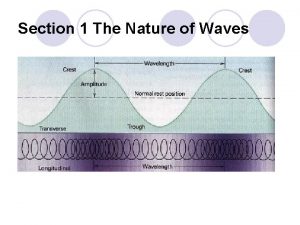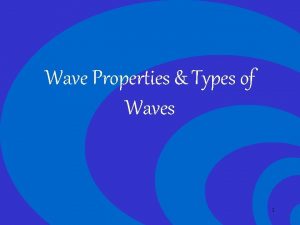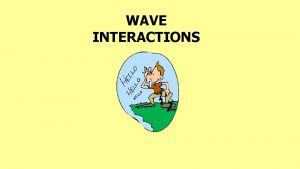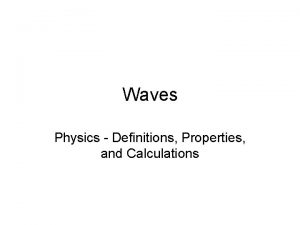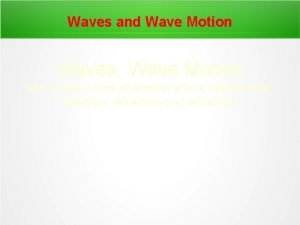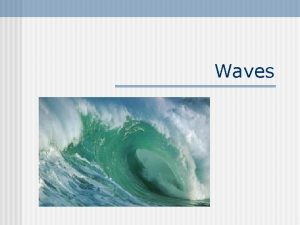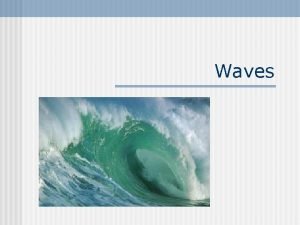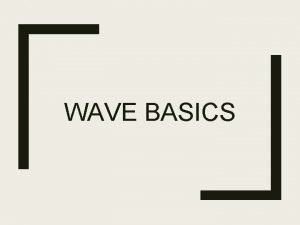Waves Definitions of Waves n A wave is





















- Slides: 21

Waves

Definitions of Waves n A wave is a traveling disturbance that carries energy through space and matter without transferring mass. n n n Transverse Wave: A wave in which the disturbance occurs perpendicular to the direction of travel (Light). Longitudinal Wave: A wave in which the disturbance occurs parallel to the line of travel of the wave (Sound). Surface Wave: A wave that has characteristics of both transverse and longitudinal waves (Ocean Waves). Wave types

Types of Waves Mechanical Waves: Require a material medium* such as air, water, steel of a spring or the fabric of a rope. n Electromagnetic Waves: Light and radio waves that can travel in the absence of a medium. n * Medium = the material through which the wave travels.

Transverse Wave Characteristics n n n Crest: The high point of a wave. Trough: The low point of a wave. Amplitude: Maximum displacement from its position of equilibrium (undisturbed position). John Wiley & Sons

Transverse Wave Characteristics (cont. ) n n n Frequency(f): The number of oscillations the wave makes in one second (Hertz = 1/seconds). Wavelength( ): The minimum distance at which the wave repeats the same pattern (= 1 cycle). Measured in meters. Velocity (v): speed of the wave (m/s). v = f n Period (T): Time it takes for the wave to complete one cycle (seconds). T = 1/f

The Inverse Relationships v = f The speed of a wave is determined by the medium in which it travels. n Since velocity is constant for a given medium, the frequency and wavelength must be inversely proportional. • As one increases, the other decreases Frequency n Wavelength

The Inverse Relationships T = 1/f Similar to the inverse relationship for frequency and wavelength, a similar relationship exists for frequency and the period. Frequency n Period

Speed of a Wave on a String n n For a stretched rope or string: FT v= μ Where: FT = Tension μ = linear density = m/l As the tension increases, the speed increases. As the mass increases, the speed decreases. Can you relate this to a string on a piano or guitar?

Waves at Fixed Boundaries n n A wave incident upon a fixed boundary will have its energy reflected back in the opposite direction. Note that the wave pulse is inverted after reflecting off the boundary. Example of Waves at Fixed Boundaries www. electron 4. phys. utk. edu

Interference n Interference occurs whenever two waves occupy the same space at the same time. n Law of Linear Superposition: When two or more waves are present at the same time at the same place, the resultant disturbance is equal to the sum of the disturbances from the individual waves.

Constructive Wave Interference Constructive Interference – Process by which two waves meet producing a net larger amplitude. www. electron 4. phys. utk. edu

Destructive Wave Interference Destructive Interference – Process by which two waves meet canceling out each other.

Standing Waves n Standing Wave: An interference pattern resulting from two waves moving in opposite directions with the same frequency and amplitude such that they develop a consistent repeating pattern of constructive and destructive interference. n Node: The part of a standing wave where interference is destructive at all times (180 o out of phase). n Antinode: The part of the wave where interference is maximized constructively (in phase). n Standing Wave

Continuous Waves n n n When a wave impacts a boundary, some of the energy is reflected, while some passes through. The wave that passes through is called a transmitted wave. A wave that is transmitted through a boundary will lose some of its energy. n n n Electromagnetic radiation will both slow down and have a shorter wavelength when going into a denser media. Sound will increase in speed when transitioning into a denser media. Speed of Light in different mediums

Continuous Waves – Higher Speed to Lower Speed n Note the differences in wavelength and amplitude between of the wave in the two different mediums Transmitted Wave v 2 Displacement Incident + Reflected Wave -v 1 Boundary Higher speed Lower speed Longer wavelength Shorter wavelength Note: This phenomena is seen with light traveling from air to water.

The Wave Equation n Sinusoidal waves can be represented by the following equation. y(x, t) = ymsin( t - x) Where: ym = amplitude = angular wave number (2 / ) x = position = angular frequency (2 f) t = time n Note that the sum ( t - x) is in radians, not degrees.

The Wave Equation y(x, t) = ymsin( t - x) Phase Amplitude n = 2 / Waveform repeats itself every 2. n n +x = 2 f Waveform travels through 1 period (T) every 2. A phase constant ( ) can be included in the phase that represents all waves that do not pass through the origin.

The Wave Equation – An Alternate Representation y(x, t) = ymsin( t - x) n Substituting for (2 f), (2 / ) and ym (A) yields: or y(x, t) = Asin 2 (ft - 1 x) y(x, t) = Asin 2 (vt - x)

Waves at Boundaries Examples of Waves at Boundaries n Wave Types (Cutnell & Johnson) n Waves - Colorado. edu n

Key Ideas n n Waves transfer energy without transferring matter. Longitudinal waves like that of sound require a medium. Transverse waves such as electro-magnetic radiation (light) do not require a medium. In transverse waves, displacement is perpendicular to the direction of the wave while in longitudinal waves, the displacement is in the same direction.

Key Ideas n n Waves can interfere with one another resulting in constructive or destructive interference. Standing waves are a special case of constructive and destructive interference for two waves moving in opposite directions with the same amplitude, frequency and wavelength.
 Mechanical and electromagnetic waves venn diagram
Mechanical and electromagnetic waves venn diagram Half full wave rectifier
Half full wave rectifier Longitudinal wave
Longitudinal wave Short wave vs long wave radiation
Short wave vs long wave radiation Mechanical and electromagnetic waves
Mechanical and electromagnetic waves Full wave rectifier example
Full wave rectifier example Wave wave repeating
Wave wave repeating Difference between full wave and half wave rectifier
Difference between full wave and half wave rectifier Velocity frequency wavelength triangle
Velocity frequency wavelength triangle Earthquake p wave and swave travel time
Earthquake p wave and swave travel time Wave symmetry
Wave symmetry Difference between transverse wave and longitudinal wave
Difference between transverse wave and longitudinal wave Rectified sine wave fourier series
Rectified sine wave fourier series Sound waves are transverse waves true or false
Sound waves are transverse waves true or false Ability of two or more waves to combine and form a new wave
Ability of two or more waves to combine and form a new wave Seismic waves are mechanical waves
Seismic waves are mechanical waves Similarities of mechanical waves and electromagnetic waves
Similarities of mechanical waves and electromagnetic waves Mechanical vs electromagnetic waves
Mechanical vs electromagnetic waves Compare and contrast p waves and s waves using venn diagram
Compare and contrast p waves and s waves using venn diagram Characteristics of a longitudinal wave
Characteristics of a longitudinal wave Mechanical waves and electromagnetic waves similarities
Mechanical waves and electromagnetic waves similarities What are constructive waves
What are constructive waves














